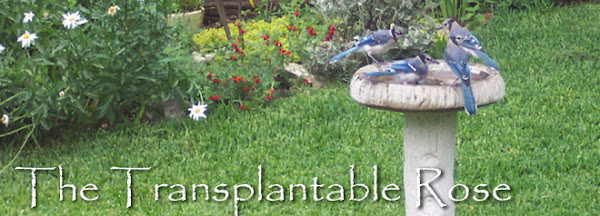DECEMBER 5, 2014: Are you seeing this blog post on blogspot? Or are you seeing it at TexasOutdoorsmen dot com?
if you're seeing my posts and photos on the TexasOutdoorsmen dot com site, it is absolutely without my permission. This website has been copying my garden blog and garden blogs belonging to many of my garden friends, and we want it to stop.
This post, Passalongs and Reseeders Say Happy Autumn, was written by Annie in Austin for her Transplantable Rose blog.
Many of the current flowers descend from plants bought years ago. The original plants are long gone, but seedlings can keep a strain going through repeated reseeding.
The original Gaura lindheimeri started in a patio container - it was a short-lived perennial, but eight years later there's a convention being held in the front center bed.

A 4-inch pot from a Sunshine Community Gardens sale in 2005 held one seedling Blue Butterfly pea/ Clitoria ternatea. I usually save a few seeds just in case, but this year's vine sprouted on its own.

Orange cosmos seeds gleaned from the courtyard garden of a long-gone restaurant produced plants that make several generations every year... goldfinches like them. The harsh freezes of March knocked off all the existing plants of Salvia coccinea/Hummingbird sage, and germination of what seeds still lay in the ground was slow. Now in September, the annual Hummingbird sage blooms in every corner of the garden, red, orange, pink, coral and white. Planting them together near the fluorescent 'Catawba' crepe myrtle was not my idea!

Some seedlings are promises rather than Plants. Here are a few bluebonnet seedlings with cilantro. If at least a few of these sprouts can survive snails, pillbugs & cold freezes, we'll be very happy.

The passalong plants of September are not reseeders - they are houseplants, bulbs, native plants and perennials.
One small passalong Stapelia plant from my Aunt Phyll has supplied many rooted cuttings over the years - this one is blooming 25 years after she gave me the original plant.

Whether you call them Oxblood Lilies or Schoolhouse Lilies, anyone who gets a passalong Rhodophiala bifida bulb is a lucky Austin gardener. Most of the bulbs in my garden are offsets from the originals shared by MSS of Zanthan Gardens in 2006. The first flowers were open on September 8th this year
The last of the red bells hung on today, September 30th
Pam Penick of Digging and Lawn Gone fame gave me this passalong Mexican Oregano in February 2007 - it's happy with the recent weather
In May 2007, Marthachick gave me a sack full of unidentified Crinum bulbs - I planted them all over and one of them ended up in a large permanent container on the edge of the patio.
The very first bloom on September 19th was a lovely surprise.
From every angle, it's a winner!
In spring of 2008 my friend Ellen gave me a start from her Blue Butterfly clerodendron/Clerodendrum ugandense, one that's been seen in many a blog post. This well-established plant froze hard to the roots in March but recovered to start blooming in late summer. New flower heads should keep developing until a freeze stops the fun. And it's cool to know that Ellen's plant had been passed along to her from her mother-in-law. I've tried my hand at propagating Blue Butterfly from cuttings with very limited success, but I won't give up yet - it needs to be passed along to someone else.
A couple of years after we moved here, I bought a few bulbs of Lycoris radiata/Red Spider Lilies AKA Hurricane lilies and planted them. They made leaves, but I never saw a flower. Then in November 2008, MSS of Zanthan Gardens divided and shared some of her Red Spider Lilies. The Divas of the Dirt had made a sunny new bed in the front yard earlier that year so I tucked some of the bulbs in there. In 2009 every Lycoris produced leaves only, but in 2010 the remnants of Hurricane Hermine arrived with 13" of rain and tada! Hurricane lilies. This year a few inches of rain were enough to coax them out.
Some of the Lycoris were planted near the Sweet Olive but it was too shady. Last fall I transplanted the bulbs to this bulb bed and they responded like this.
Did you notice the dates on the above passalong plants? I really expected that by now the bulbs would have flourished and increased so they could be freely shared - but that didn't happen. At least some of each plant is alive, but year after year of heat and drought seems to have kept these plants from multiplying the way they once did.
The final passalong plant for September is a new one to me - GoldenEye Sunflower/Viguiera dentata. It's native to Central Texas.
Tina of the My Gardener Says blog sent me home with two starter plants last November, saying the finches would like them.
I planted them near the back fence and crossed my fingers.
The little plants were alive through winter, but the killer March deep-freeze knocked them back to below ground. I was thrilled to see leaves emerge in mid-April and watched the 2 plants slowly bulk up through the summer. Buds appeared earlier in September and then the golden daisies began to open
I like their sunny faces, and the plant is a good size for this spot.
Thank you for a flowery September to so many sharing gardeners! To MSS at Zanthan Gardens to Pam at Digging, and Tina at My Gardener Says, thank you to MarthaChick, thank you good friend Ellen and thank you to dear Aunt Phyll.
This post, Passalongs and Reseeders Say Happy Autumn, was written by Annie in Austin for her Transplantable Rose blog.




































